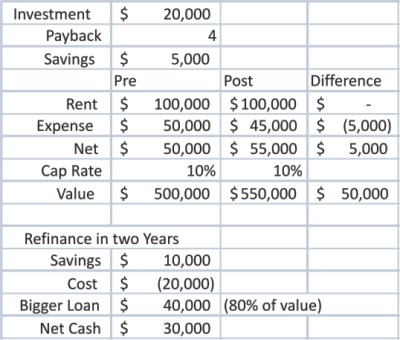
Rant fans are getting a break this week. This post exemplifies a smashing success in energy efficiency and is a bit of a spinoff on capitalizing energy efficiency as I discussed in Facility Management, Taliban Style and Better than Doritos.
The story begins with a board meeting for the Iowa Association for Energy Efficiency. BTW, this is the least expensive, far and away, greatest-benefit-per-dollar-invested energy efficiency organization in the country.
The board meeting was at an apartment complex, Sun Prairie, in West Des Moines or thereabouts. As I pulled in with 134F heat at 9:30 AM, I was thinking, “Is this the right place? Why are we meeting here?” This looks like a run-of-the-mill, but well maintained apartment complex. That’s where that para dig em ends.
This all began with the apartment complex owner/president, Keith Denner, in 1988[1] as they started building apartment buildings. The last one was built in 2003.
In my 17 years of experience in this business, this story is amazing for the following reasons:
- These multi-family facilities are very efficient, as measured by bills, not fru fra. Note, this is the first sentence in the history of the English language that multi-family and efficient appear in the same sentence.
- Mr. Denner knows precisely how to plow the benefits back into his business. He’s generating volumes of politically incorrect wealth from energy efficiency! Man, I love it. The DOE was obviously not the instigator of this business model.
There is no magic to the savings generated by these facilities. However, Mr. Denner smashes the mold of the owner tenant relationship and leasing agreements related to energy cost.
These facilities feature hot water heating systems served by efficient boilers. Again, this is more expensive than the usual cheap and crappy electric baseboard heating, but it comes with a vision of leveraging the value it provides. Apartments are cooled by through-wall air conditioners, the efficiency of which is lousy[2], but it doesn’t matter because: walls have R-19 cavity (between studs) insulation with an inch of rigid insulation over the studs – this is huge – and R-50 or so attic insulation. Windows have “quilt” blinds, which to me sounds kind of clunky but they are not. The key is they probably add about R5 to the windows insulation value, but more importantly they have tracks forming a quite effective seal to minimize otherwise unstoppable convection associated with conventional blinds. The result is these blinds are literally at least 10x more effective at blocking heat transfer than other blinds[3].
More recently, there was a project to install more efficient boilers, replace all toilets (don’t laugh or roll your eyes), variable frequency drives, steel shingles, and solar water heating (go ahead laugh and roll your eyes). The solar water heating was required by the profit averse DOE to get a grant to include a study on the cost effectiveness of this recent project / portfolio of measures.
Here is another eye popper to me. All toilets in the complex were replaced at a cost of about $250,000, with annual savings of about $175,000. Yeow! The new ones are Niagara Stealth 0.8 gallon per flush. Before you howl how they work, Mr. Denner states they have fewer clogs than with the former standard 1.6 gpf units. You can YouTube the Stealth yourself to see it in action but I wouldn’t recommend it. Let’s just say the Stealth could probably swallow a 15 pound woodchuck, whole.
Water consumption, after the toilet replacement, dropped by half. How is this? The new toilets have a newfangled flush valve that does not leak. Rather than the common flipper valve on toilet tanks, this has a button in the middle of the tank lid. I don’t know how it works or what the difference is. Consider it a homework assignment.
Here’s another amazing thing: Mr. Denner guarantees electric bills will not surpass $30, $35, and $45 per month, per apartment for one, two, and three bedroom units – and this includes a fixed charge of almost $10, and of course it covers summer peak use. In fact, he is “lobbying” the regulators to allow him to consolidate meters into one for each building or even the entire site. He will pay the bill and pass the fixed cost to the tenants. What’s the benefit of consolidating meters – massive meter charge savings equal to roughly one third to one half the entire electric bill.
Actually, he wants to consolidate everything into one bill for tenants: rent, electricity, heat, cable/satellite TV, and internet. This would be a huge hassle saver for people moving in and they are therefore willing to pay for it.
Individual meters are supposed to keep tenants from wasting energy willy nilly. This is silly (hey, it just popped in there). It’s the same argument that higher mileage cars will simply result in more driving. What a bunch of crap and Mr. Denner has demonstrated this, or rather, his tenants have. These buildings use so little energy, people can set the temperature wherever they want and it doesn’t make much difference. As Mr. Denner states, setting up the thermostat during the day in the cooling season doesn’t save squat because the Btus just pile up and need to be removed when people come home at night. This is consistent with what I’ve always said about programmable stats and cooling.
The installation of variable frequency drives on hot water pumps may not have had a great return on investment from energy savings alone. However, the resultant lower operating water pressure reduced control valve replacement by a reported 90%. These well-insulated buildings require little heating and thus hot water flow requirements are low to zero much of the time. With high operating pressure from full speed pumps, the valve seats will erode like open flowing water erodes soil. The result is the valve no longer can stop flow; the rooms overheat and the windows come open. Maintenance sees this and replaces the valve; a rather expensive and labor-intensive undertaking.
And another thing – instead of having crappy bottom of the line appliances, he offers new ENERGY STAR® rated appliances and new air conditioner for an extra $25 per month. Tenants gladly cough it up. The extra rent for these energy saving appliances is more than the total energy bill for the apartment. Add to that substantial maintenance savings associated with new equipment.
He also provides the CFLs – free. There must be a line beating a trail to the rental office to get into this place.

Lastly, Mr. Denner leverages his investments in EE to raise capital for expansion. The example he gives is virtually the same as the table nearby. This includes an investment in EE of $20,000 on a project with a four year payback. Conventional wisdom is the investment that will break even after four years. Really?
Per my understanding, this sort of property is refinanced about every three years. Assume an investor expects 10% return on investment. Increased income increases the value of the property for refinancing, in this case by a whopping $50,000. After TWO years the net cash in pocket is $30,000 – a little better scenario than $0 after four years, like the dunderhead payback “valuation” method.
And this isn’t like cashing the equity out of the facility, making for a house of cards that eventually collapses. It isn’t speculative either. It is real and the lenders accept that.
None of this is rocket surgery. It just takes an open mind and viewing facilities as a money machine rather than a dreaded necessary evil that must be built and maintained as cheaply as codes will allow, and then some. This is real pioneering stuff and Mr. Denner deserves… well his bottom line provides his just desserts. Let’s just say I wouldn’t expect to see him shaking hands with Secretary Chu on TV anytime – this is the anti-Solyndra.
[2] I would use these too in this building. Decent EERs in the 15 range are simply not available.
[3] A wild but reasonably conservative engineering guess.




